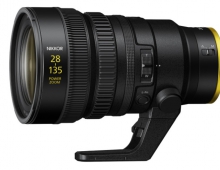
Nikon Develops Digital Camera with Wi-Fi Function
Nikon said Thursday it has developed what it says is the world's first digital camera with a built-in function allowing users to transmit image data wirelessly to printers and personal computers.
The Coolpix P1 with the wireless local area network capability frees users from the complications
of having to connect the camera to printers and PCs with a cable or card reader.
The 8-megapixel P1 measure 3.6 inches by 2.4 inches by 1.5 inches, weigh 6 ounces and sport a 2.5-inch LCD screen. The new cameras can also record video at a rate of up to 30 frames per second with a choice of seven movie modes. Sound records in six of those modes.
The camera can transmit image data to a PC up to 30 meters away from the user, Nikon said, adding that it will put the camera on the market Sept. 15 for about $550.
When a Coolpix P1 user shoots in the shoot-and-transfer mode, images are transferred to the PC at the moment they are taken.
If the easy transfer mode is selected, a user can select certain images or dates from which images can be transferred.

In addition, if the wireless print mode is selected, a user can print directly to a printer.
Nikon said it wants to differentiate the camera from an increasingly crowded domestic digital camera market on the strength of its wireless LAN functionality.
Cameras that use wireless connections to upload pictures or to print photos aren't new. Many models use Bluetooth technology to get the job done, but only a handful of companies are investing in Wi-Fi to connect cameras to other devices.
Earlier this year, Kodak began selling its EasyShare-One camera with an optional 802.11 Wi-Fi card
In late August, Matsushita Electric Industrial Co. took the wraps off a new version of its Lumix camera capable of automatically correcting blurred images due to hand movement.
Sony is set to introduce a new version of its Cybershot camera, whose body is as thin as 1.5 cm, on Sept. 9.
Nikon General Manager Kazuyuki Kazami said, "Certain models of digital cameras compete with mobile phones with built-in digital cameras."
"We feel that the domestic market is being saturated," he said, adding that Nikon is hoping to cash in on overseas markets such as Russia and Scandinavian and other northern European nations.
The 8-megapixel P1 measure 3.6 inches by 2.4 inches by 1.5 inches, weigh 6 ounces and sport a 2.5-inch LCD screen. The new cameras can also record video at a rate of up to 30 frames per second with a choice of seven movie modes. Sound records in six of those modes.
The camera can transmit image data to a PC up to 30 meters away from the user, Nikon said, adding that it will put the camera on the market Sept. 15 for about $550.
When a Coolpix P1 user shoots in the shoot-and-transfer mode, images are transferred to the PC at the moment they are taken.
If the easy transfer mode is selected, a user can select certain images or dates from which images can be transferred.

In addition, if the wireless print mode is selected, a user can print directly to a printer.
Nikon said it wants to differentiate the camera from an increasingly crowded domestic digital camera market on the strength of its wireless LAN functionality.
Cameras that use wireless connections to upload pictures or to print photos aren't new. Many models use Bluetooth technology to get the job done, but only a handful of companies are investing in Wi-Fi to connect cameras to other devices.
Earlier this year, Kodak began selling its EasyShare-One camera with an optional 802.11 Wi-Fi card
In late August, Matsushita Electric Industrial Co. took the wraps off a new version of its Lumix camera capable of automatically correcting blurred images due to hand movement.
Sony is set to introduce a new version of its Cybershot camera, whose body is as thin as 1.5 cm, on Sept. 9.
Nikon General Manager Kazuyuki Kazami said, "Certain models of digital cameras compete with mobile phones with built-in digital cameras."
"We feel that the domestic market is being saturated," he said, adding that Nikon is hoping to cash in on overseas markets such as Russia and Scandinavian and other northern European nations.





















